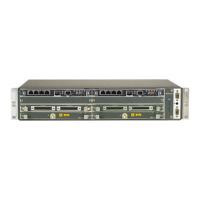User Manual
Product information and planning
9500 MPR Rel. 3.1
3DB18809AAAA Issue 1160/980
2.8.9 Stacking for EAS unit/MPT Access unit
Two EAS units or two MPT Access units installed on the same row (i.e. slot #3 and slot #4) are automat-
ically configured in stacking configuration.
The benefits of the stacking are:
1) the intra-board traffic between the two units does not transit through the Core-E unit (no traffic
impact in case of Core-E switch);
2) each port of the units can be individually segregated from the other ports.
2.8.10 Ethernet Ring Protection
The implemented Ethernet Ring Protection Switching (ERPS) is according to ITU-T G.8032 recommen-
dation. The ERPS is a protection mechanism for Ethernet ring topologies.
2.8.10.1 Definitions
2.8.10.1.1 Topology
An ERPS Topology is a collection of Ethernet Ring Nodes forming a closed physical loop. Each Ethernet
Ring Node is connected to two adjacent Ethernet Ring Nodes via a duplex communications facility. Only
one topology is supported.
Note: The minimum number of Ethernet Ring Nodes in an Ethernet Ring is 3 and the max. number is 16.
2.8.10.1.2 Ring Link and Ring Port
Each Ethernet Ring Node is connected to adjacent Ethernet Ring Nodes participating in the same ERPS
Topology, using two independent Ring Links. A Ring Link is bounded by two adjacent Ethernet Ring Nodes
and a port for a Ring Link is called a Ring Port.
2.8.10.1.3 Ring Protection Link (RPL)
The loop avoidance in the ring is achieved by guaranteeing that, at any time, traffic may flow on all but
one of the Ring Links. This particular link is called the Ring Protection Link (RPL).
2.8.10.1.4 RPL Owner
One designated node, the RPL Owner, is responsible to block traffic over the RPL.
Under a ring failure condition, the RPL Owner is responsible to unblock the RPL, allowing the RPL to be
used for traffic.
2.8.10.1.5 R-APS Protocol
An APS protocol, called R-APS (Ring Automatic Protection Switching), is used to coordinate the protec-
tion actions over the ring.

